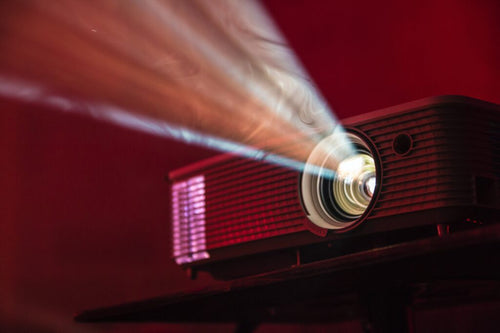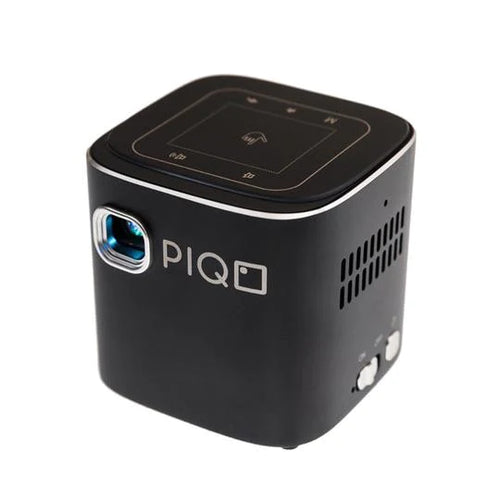Brighten Up Your Viewing Experience: Exploring High Lumen Projectors

In this digital age, where visual content has become an integral part of our lives, having a high-quality projection system is essential. High lumen projectors like PIQO deliver exceptional brightness, clarity, and detail, even in well-lit environments. Whether hosting a movie night at home, giving a business presentation, or teaching in a classroom, high lumen projectors can make a difference.
In this article, we will explore the benefits of high lumen projectors, and how they can enhance your viewing experience to new heights. Let’s begin!
What are High Lumen Projectors?
High lumen projectors display large-scale visuals with exceptional brightness and clarity. They utilize advanced lamp technologies and optics to produce brighter images than standard projectors. The lumen rating represents the brightness output of a projector, and high lumen projectors typically have a rating of 3000 lumens or more.
Benefits of High Lumen Projectors
High lumen projectors offer numerous benefits. Some of them are as follows:
1. Enhanced Brightness and Clarity
With a high lumen rating, these projectors can produce vibrant images even in brightly lit rooms or outdoor environments. This feature makes them perfect for presentations, events, and gatherings where ambient light may be challenging. The increased brightness ensures the audience can view the content without straining their eyes.
2. Ideal for Large Venues and Outdoor Events
High lumen projectors are well-suited for large venues and outdoor events. Whether it's a conference hall, auditorium, or stadium, these projectors can deliver immersive visuals to an audience. They also withstand various environmental conditions, making them suitable for outdoor screenings, concerts, and sports events.
3. Versatility in Usage
High lumen projectors offer flexible connectivity options, allowing seamless device integration. This versatility makes high lumen projectors adaptable to different requirements and ensures a high-quality visual experience in diverse scenarios.
4. Energy Efficiency
Despite their powerful brightness, designers of high lumen projectors ensure they are energy efficient. They utilize advanced lamp technologies and optimization techniques to minimize power consumption without compromising performance. This energy efficiency not only reduces environmental impact but also lowers operating costs. With high lumen projectors, users can enjoy exceptional visuals while mindful of energy consumption.
5. Longevity and Durability
High lumen projectors are built to last. They incorporate durable components and robust construction, ensuring long-term performance and reliability. The designers have designed these projectors to withstand continuous usage without significantly degrading image quality.
High lumen projectors can provide years of exceptional visual experiences with proper maintenance and care, making them a worthwhile investment for personal and professional use.
6. Portability and Easy Setup
While high lumen projectors offer powerful performance, they are also designed to be portable and easy to set up. Many models feature compact designs and lightweight construction, allowing users to transport them conveniently to different locations.
The setup process is typically straightforward, with user-friendly interfaces and intuitive controls. Whether hosting a movie night with friends or conducting a business presentation in a new venue, high lumen projectors enable hassle-free installation and quick deployment.
7. Cost-Effectiveness
Investing in a high lumen projector can be a cost-effective solution in the long run. While the initial purchase cost may be higher than standard projectors, the enhanced brightness and longevity of high lumen projectors compensate for the investment.
Their ability to deliver vivid visuals in various environments reduces the need for additional lighting equipment or venue modifications. Furthermore, the durability of these projectors minimizes maintenance and replacement expenses over time, resulting in overall cost savings.
8. Immersive Home Theater Experience
High lumen projectors offer an immersive home theater experience for cinephiles and home entertainment enthusiasts. These projectors can transform any room into a cinematic environment with their high brightness and clarity.
Whether you're watching movies, streaming your favorite shows, or gaming, high lumen projectors provide a large-scale display with stunning visuals. The immersive experience brings the content to life, making it an excellent choice for those seeking an unparalleled cinematic experience at home.
9. High-Quality Presentations in Business Settings
In business settings, high lumen projectors elevate the quality of presentations. Whether it's a boardroom meeting, sales pitch, or conference, these projectors ensure that your visuals have a professional and impactful appeal. The bright and clear display lets you precisely showcase data, graphs, and multimedia content. With high lumen projectors, you can engage your audience effectively and make a lasting impression during important business interactions.
10. Educational Applications
High lumen projectors have significant applications in the field of education. These projectors enhance the learning experience in classrooms and training environments by providing visually engaging content.
Teachers and trainers can display educational materials, presentations, and interactive lessons with exceptional clarity, capturing students' attention and improving knowledge retention. High lumen projectors promote interactive learning and create an immersive environment that fosters curiosity and engagement.
11. Gaming and Entertainment
Gamers can benefit greatly from high lumen projectors. The large-scale visuals create a more immersive gaming experience, pulling players into the virtual worlds of their favorite games.
Whether action-packed adventures or multiplayer competitions, high lumen projectors deliver vibrant and detailed visuals that enhance the excitement. Additionally, these projectors can be combined with surround sound systems to create a truly immersive gaming setup.
Factors to Consider when Choosing a High Lumen Projector
When selecting a high lumen projector, several factors should be taken into consideration:
1. Brightness and Lumens
The brightness of a projector is measured in lumens. When choosing a high lumen projector, it's important to consider the environment. Larger venues require projectors with higher lumen outputs to combat ambient light. A projector with a lower lumen output may be sufficient for home theaters or small meetings.
2. Resolution
Resolution refers to the number of pixels that make up the projected image. High-definition resolutions such as Full HD (1920x1080 or 4K (3840x2160) offer crisp and sharp images. Consider the projector's intended use and select a resolution that matches your needs.
3. Connectivity Options
Ensure that the projector you choose offers a variety of connectivity options to connect with different devices. HDMI, VGA, USB, and wireless connectivity are common features to look for. Compatibility with your devices, such as laptops, gaming consoles, or streaming devices, is crucial for a seamless user experience.
4. Lamp Life and Maintenance
Lamp life refers to the number of hours a projector lamp can be used before it needs to be replaced. Longer lamp life translates to lower maintenance costs. Consider the average lamp life of the projector and factor in the replacement cost when deciding.
5. Throw Distance
The throw distance is between the projector and the screen or projection surface. It determines the size of the projected image. Consider the available space and the desired screen size to choose a projector with the appropriate throw distance range.
6. Keystone Correction
Keystone correction is a feature that allows you to adjust the shape of the projected image to compensate for the projector's angle. It ensures that the image appears rectangular and not distorted. Look for projectors with automatic or manual keystone correction for optimal image quality.
7. Aspect Ratio
The aspect ratio refers to the proportional relationship between the width and height of the projected image. Common aspect ratios include 4:3 (standard), 16:9 (widescreen), and 16:10 (widescreen). Choose an aspect ratio that suits your content and intended use.
8. Image Quality
Consider the projector's image quality, including color accuracy, contrast ratio, and black levels. High-quality lenses and advanced image processing technologies can significantly enhance the visual experience.
9. Portability
Portability becomes an important factor if you plan to use the projector in different locations or for frequent travel. Look for compact and lightweight projectors that are easily transported without compromising performance.
10. Sound System
While projectors generally have built-in speakers, the sound quality may only sometimes meet your expectations. If audio is a crucial aspect of your presentations or entertainment, consider connecting external speakers or opting for projectors with enhanced audio capabilities.
Setting Up the High Lumen Projector
To make the most of your high lumen projector, follow these steps for a seamless setup:
1. Finding the Ideal Location
Start by finding the ideal location for your projector. Consider room size, ambient lighting, screen or wall position, and audience seating arrangement. Ensure that the projector's throw distance aligns with your desired screen size.
2. Connecting the Projector to Power
Connect the projector to a power source using the provided power cable. Ensure the outlet is easily accessible and can handle the power requirements of the projector.
3. Connecting the Projector to a Video Source
Connect the projector to your video source, such as a laptop, DVD player, or gaming console. Use the appropriate cables, such as HDMI or VGA, to establish a connection. Ensure the projector and the video source are powered off before connecting.
4. Adjusting the Projector Settings
Once the connections are made, power the projector and navigate through the on-screen menu to adjust settings like aspect ratio, display mode, and input selection. Experiment with these settings to achieve the best image quality.
Optimizing Image Quality
To get the best possible image quality from your high lumen projector, follow these steps:
1. Adjusting Keystone and Lens Shift
If the projector is not perfectly aligned with the screen, you may need to adjust the keystone correction or lens shift. These features help correct image distortion caused by the projector's position.
2. Focusing the Projector
Ensure that the projected image is sharp and in focus. Adjust the focus ring on the projector until the image appears clear.
3. Calibrating Colors and Contrast
Fine-tune the color and contrast settings to optimize the image quality. Most projectors offer brightness, contrast, color saturation, and color temperature adjustment options.
Positioning and Mounting Options
Consider the following options for positioning and mounting your high lumen projector:
1. Tabletop Placement
You can place the projector on a table or flat surface if portability is essential. Make sure the projector is stable and secure.
2. Ceiling Mount Installation
For a permanent setup, consider mounting the projector on the ceiling. Use a ceiling mount kit designed for your projector model. Ensure the projector is aligned with the screen and securely fastened.
Using the High Lumen Projector
Once the setup is complete, you can use the high lumen projector to enjoy your desired content. Here are some essential steps:
1. Selecting Input Sources
Choose the desired input source on the projector, whether it's HDMI, VGA, USB, or wireless connectivity. Ensure that the video source is powered on and transmitting the signal.
2. Adjusting Projection Size
Experiment with the projector's distance from the screen to achieve the desired projection size. Refer to the projector's manual for the optimal throw distance and screen size recommendations.
3. Utilizing Keystone Correction
If the projector is not positioned directly in front of the screen, use the keystone correction feature to adjust the image geometry and maintain a rectangular shape.
4. Enhancing Audio Experience
Connect external speakers or utilize the projector's built-in audio capabilities to enhance the audio experience. Adjust the audio settings for optimal sound quality.
5. Controlling the Projector Remotely
Most projectors come with a remote control for convenient operation. Familiarize yourself with the remote's functions and use it to control the projector from a distance.
Maintenance and Care
To ensure the longevity and optimal performance of your high lumen projector, follow these maintenance and care practices:
1. Cleaning the Projector
Regularly clean the projector's lens and vents to prevent dust buildup. Use a soft cloth and non-abrasive cleaning solution to wipe the lens gently. Follow the manufacturer's instructions for cleaning other parts.
2. Replacing the Lamp
High lumen projectors use lamps that have a limited lifespan. When the lamp starts to dim or reaches the end of its life, replace it with a compatible lamp according to the manufacturer's instructions.
3. Updating Firmware
Check for firmware updates for your projector model regularly. Firmware updates often introduce new features, enhance performance, and fix potential issues. Follow the manufacturer's instructions to update the projector's firmware.
Troubleshooting Common Issues
Encountering issues with your high lumen projector can be frustrating. Here are some common problems and troubleshooting tips:
1. No Picture or Image Display
Check the connections between the projector and the video source. Ensure that the correct input source is selected on the projector. Verify that both the projector and the video source are powered on.
2. Poor Image Quality
Adjust the projector's settings, such as brightness, contrast, and color calibration, to improve the image quality. Ensure the video source's resolution matches the projector's native resolution for optimal image clarity.
3. Overheating and Fan Noise
Ensure that the projector has proper ventilation and is not placed in an enclosed space. Clean the projector's vents to remove any dust or debris obstructing airflow. If the issue persists, contact customer support for further assistance.
4. Remote Control Malfunction
Check the batteries in the remote control and replace them if necessary. Ensure that there are no obstructions between the remote control and the projector. If the problem continues, try resetting the remote control or contacting customer support.
5. Projector Not Powering On
Check the power connections and make sure the projector is properly plugged in. Try using a different power outlet or power cable. If the issue persists, consult the user manual or contact customer support.
Final Thoughts
High lumen projectors offer an incredible opportunity to elevate your viewing experience. Whether you want to enjoy immersive home theater, deliver impactful business presentations, enhance educational environments, or organize memorable outdoor events, high lumen projectors provide the brightness and clarity needed to make a lasting impression. Embrace the power of high lumen projectors and unlock a world of visual pos






